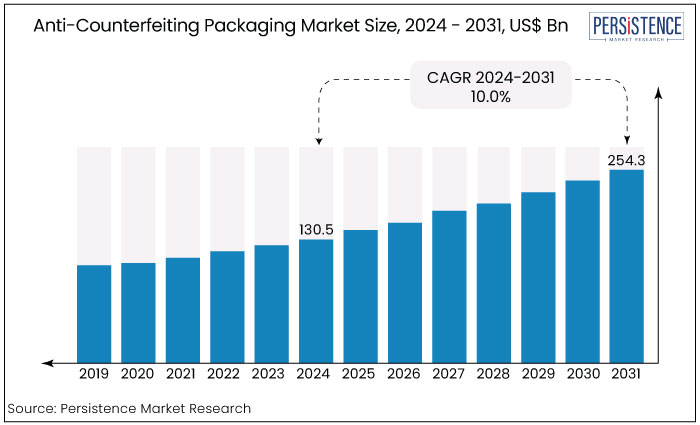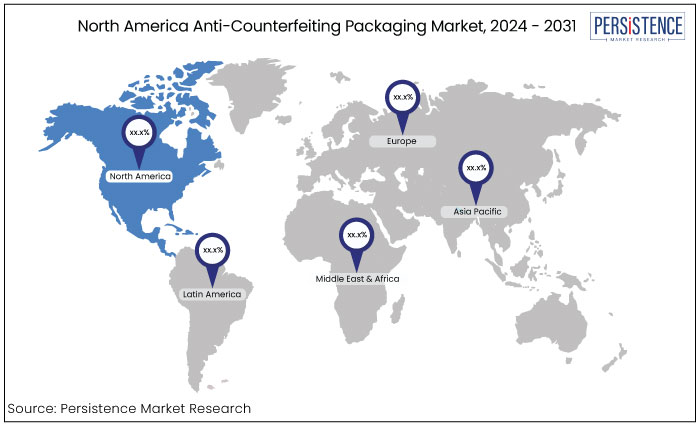PMR Indicates in a New Report that the Increasing Requirement to Protect Consumer Safety Will Drive Demand for Anti-Counterfeiting Packaging Solutions
Industry: Consumer Goods
Format: PPT*, PDF, EXCEL
Delivery Timelines: Contact Sales
Report Type: Ongoing
Report ID: PMRREP3320
The global anti-counterfeiting packaging market is estimated to increase from US$130.5 Bn in 2024 to US$254.3 Bn by the end of 2031. The market is projected to expand at a CAGR of 10.0% during the forecast period from 2024 to 2031.

Key Highlights of the Market
|
Attributes |
Key Insights |
|
Anti-Counterfeiting Packaging Market Size (2024E) |
US$130.5 Bn |
|
Projected Market Value (2031F) |
US$254.3 Bn |
|
Forecast Growth Rate (CAGR 2024 to 2031) |
10.0% |
|
Historical Growth Rate (CAGR 2019 to 2023) |
8.5% |
Packaging plays a crucial part in various industries such as food and pharmaceuticals. The most essential method to avoid counterfeiting is secure packaging.
Anti-counterfeiting is one of the important processes of secure packaging that prevents copying and confirms the security of products.
Manufacturers are minimizing their loss which has mainly occurred due to counterfeiting of products with the help of anti-counterfeiting technology.
A few of the key drivers fueling the demand for anti-counterfeiting packaging solutions are-
There is rise in pharmaceutical counterfeiting in the US and across the globe too, mainly increasing the risk for millions of patients who neglect the prescription medicines they purchase are safe and effective.
Though the US pharmaceutical product distribution is one of the safest across the globe, increasing incidences of counterfeiting in the country are expected to drive the industry growth over the forecast period
High cost structure to track & trace infrastructure and lack of awareness for product originality are expected to pose severe challenges to the growth of the market.
The rise in the development of packaging techniques in pharmaceuticals and food segments fuels the market in Asia Pacific.
Increase in spending by the manufacturers in the US coupled with government to resolve problems about goods counterfeiting is anticipated to fuel the market growth during the forecast period.
For example, Pfizer has taken the advantage to protect consumers against counterfeit products. Ito ensure safety of the patient in the, the company employs RFID tags in the US on a few highly counterfeit products.
One of the vital factors propelling the demand for anti-counterfeiting packaging is the increasing incidence of counterfeit products across different industries such as electronics, luxury goods, food and beverages and pharmaceuticals.
A prominent risk posed by counterfeiting to consumer safety, revenue loss for manufacturers and brand reputation fuels the demand for robust anti-counterfeiting solutions embedded within packaging for verifying product authenticity.
The market witnessed a shift toward sophisticated anti-counterfeiting technologies including RFID tags, barcode labeling, holograms and tamper-evident seals.
Such technologies have been incorporated into packaging to track them throughout the supply chain, protect against unauthorized replication and authenticate products.
Industries such as cosmetics, electronics, luxury goods and pharmaceuticals have been especially proactive to go with these measures for safeguarding their brands and ensure consumer safety. The market recorded a CAGR of 8.5% during the historical period.
Ongoing advancements in nanotechnology, smart packaging solutions and digital printing are projected to enhance the anti-counterfeiting packaging capabilities during the future period.
Such innovations are also likely to make it hugely tough for counterfeiters to replicate packaging and deceive consumers in the forthcoming years.
Sales of anti-counterfeiting packaging are estimated to secure a CAGR of 10% during the forecast period from 2024 to 2031.
Increasing Demand for Excellent Packaging Solutions
Excellent packaging solutions greatly help to protect products from physical damage during transportation as well as storage. These solutions also incorporate anti-counterfeiting features, which safeguard against unauthorized replication.
Key features including unique serialization codes, RFID tags and holograms are integrated into packaging.
Advances in packaging technologies such as smart packaging, digital printing, and nanotechnology, have revolutionized anti-counterfeiting efforts.
These innovations enable the integration of sophisticated authentication features into packaging materials, making it increasingly difficult for counterfeiters to replicate or tamper with products.
Since technology evolves, so does the effectiveness of anti-counterfeiting packaging solutions in safeguarding against evolving counterfeit threats.
Ease in Product Monitoring Through Supply Chain
Ease in product monitoring through the supply chain remains a key driver for the market growth because of its vital role in enhancing authenticity, verification, traceability and overall supply chain security.
Anti-counterfeiting packaging solutions optimize supply chain operations facilitating effective product monitoring.
Retailers, distributors and manufacturers are able to streamline logistics, minimize the incidence of counterfeit products entering legitimate distribution channels and
Distributors, manufactures and retailers can streamline logistics, improve inventory management, and minimize the occurrence of counterfeit products entering legitimate distribution channels. This efficiency leads to cost savings, improved resource utilization, and enhanced overall supply chain performance.
Lack of Standardization
A lack of standardized regulations as well as guidelines is there around various regions and industries about anti-counterfeiting packaging needs.
This factor creates confusion and complexity for manufacturers who operate in numerous markets or supply chain networks leading to inconsistencies in implementation and compliance attempts.
There is inconsistency in how anti-counterfeiting packaging solutions are implemented across industries and regions without standardized guidelines or regulations.
This lack of uniformity makes it challenging for manufacturers to adopt and integrate anti-counterfeiting technologies into their packaging processes efficiently.
Issues in Integrating Anti-Counterfeiting Features into Existing Packaging and Supply Chain Processes
Integrating anti-counterfeiting features into existing packaging and supply chain processes becomes difficult. Compatibility problems with present infrastructure as well as workflow can arise, slowing down adoption.
Integrating anti-counterfeiting measures may involve upfront investment in new equipment, materials, and training. For businesses operating on tight budgets or thin profit margins, these costs can be prohibitive.
Integrating anti-counterfeiting measures can involve upfront investment in new materials, training and equipment. These costs can be prohibitive for businesses working on thin profit margins.
Anti-counterfeiting solutions scale efficiently as production volumes increase or as businesses expand into new markets. Assuring consistent performance and reliability around various operation scales needs careful execution.
Growing Awareness among Consumers About Potential Risks of Counterfeit Products
Increasing awareness about the risks associated with counterfeit products is fueling demand for secure packaging solutions.
Consumers are actively looking for assurance of product authenticity, especially in sectors where safety and reliability are paramount.
Consumers are increasingly concerned about the authenticity and safety of the products they purchase. They seek reassurance that the products they buy are genuine and not counterfeit, especially in sectors where counterfeit goods can pose health risks.
Advancements in Nanotechnology
Nanotechnology allows creating high-security features, which are difficult to counterfeit. For example, nanoscale patterns or structures can be embedded into packaging materials or labels, which are invisible to the naked eye but can be easily verified using specialized equipment.
Nanotechnology patterns offer opportunities to develop advanced anti-counterfeiting solutions with high security features.
Nanomaterials can be integrated into packaging for creating unique identifiers or covert markers that are difficult to replicate.
Pharmaceutical Companies Account for the Lion’s Share Share
|
Category |
Market Share through 2023 |
|
Pharmaceuticals |
23.0% |
Pharmaceutical brands invest important resources to maintain their reputation as well as protect their property. Anti-counterfeiting packaging helps in safeguarding against counterfeit products, which can damage brand integrity and trust.
The pharmaceutical segment is estimated to grow significantly. It noted over 23.0% market share in 2023. Counterfeiting of drugs has been a social and economic threat over the past numerous decades, which results into increased criminal activities.
Consequently, different anti-counterfeiting technologies including RDIFs, holograms, and invisible printing are expected to witness significant growth in pharmaceutical applications.
Pharmaceutical products have complex global supply chains, making them vulnerable to counterfeit activities at different stages of distribution.
Anti-counterfeiting packaging provides visibility and control over the entire supply chain, from manufacturing to distribution and retail, reducing the risk of counterfeit infiltration.
North America Secures the Most Significant Spot
|
Region |
Market Share through 2022 |
|
North America |
42% |
North America remains rapidly growing anti-counterfeiting packaging market, followed by Europe. The region dominated the market in 2022 and is estimated to lead throughout the forecast period.
This region recorded 42% market share during the historical period. Growing e-commerce platforms in North America contributes significantly to market growth in the region.
Increase in product safety impels the US market, which is projected to record a CAGR of 2.7% during the anticipation period. Increase in consumer concerns about authenticity as well as product packaging are propelling the demand for anti-counterfeit packaging.
Moreover, the growth of pharmaceutical and healthcare industries are significantly capturing large revenue to transfer medical products effectively.
Europe to Record High Growth Rate
Europe anti-counterfeit market is anticipated to expand at a notable rate due to the high spending capacities of manufacturers and the growing adoption of novel technologies in the region.
Strict government regulatory framework is also a prominent factor for market growth during the projection period.
Minimum 5% of the products imported in Europe are counterfeit and recording an increase with increasing imports demand.
Strict regulations against counterfeit products thus work a necessity in the region. It is expected to have a positive impact on market growth over the projection period.

June 2022
ExxonMobil Lubricants announced the launch of 'Mobil Super,' a new line of lubricants specifically designed for passenger vehicles. This introduction was part of ExxonMobil's strategy to expand its product offerings in the automotive lubricants market, catering to the growing demand for high-performance lubricants globally. 'Mobil Super is made available with enhanced packaging providing a new QR-code-based anti-counterfeit feature to verify the product authenticity on customers’ bottles.
August 2021
Avery Dennison Corporation, a worldwide leader in labelling and packaging materials announced its acquirement of Vestcom for US$1.45 Bn. This strategic move is aimed at expanding offerings of company in branded labelling for both consumer and retail packaged goods industries.
Some of the leading companies operating in the anti-counterfeiting packaging market include Avery Dennison.
The competitive landscape of the market varies by region, influenced by regulatory frameworks, market maturity, and technological adoption.
Companies with global footprints and strong distribution networks have a competitive advantage in catering to multinational clients.
Start-ups and small firms are increasingly entering the market with innovative technologies and agile business models. These players often focus on niche applications or disruptive technologies that challenge traditional market leaders.
|
Attributes |
Details |
|
Forecast Period |
2024 to 2031 |
|
Historical Data Available for |
2019 to 2023 |
|
Market Analysis |
US$ Billion for Value |
|
Key Regions Covered |
|
|
Key Countries Covered |
|
|
Key Market Segments Covered |
|
|
Key Companies Profiled |
|
|
Report Coverage |
|
|
Customization & Pricing |
Available upon request |
By Technology
By End-Use Industry
By Region
To know more about delivery timeline for this report Contact Sales

A few of the leading players in the market are Alien Technology Corp., Inksure Technologies, and Authentix Inc.
Increasing focus of product manufactures toward maintaining brand image is a prominent factor driving market growth.
The market is projected to increase from US$130.5 Bn in 2024 to US$254.3 Bn by the end of 2031.
North America is estimated to record significant share in the market.
Pharmaceuticals industry is expected to account for the significant market share.